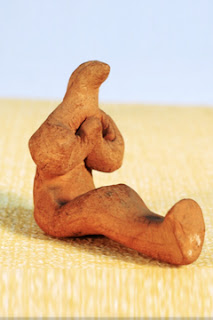·
National Museum biggest contributor for 'Yoga Chakra' at Lalit Kala Akademi
New Delhi, June 25: A man sits with his legs stretched out
and hands folded in a gesture of reverence. It is an image that could easily
fit the description of a participant of the International Yoga Day across the
world, only it is from five millennia ago. The terracota object from the
Harappa civilization, between 2700 BC and 2100 BC, is a main attraction at an
ongoing exhibition on yoga in the national capital.
 |
| Disembodied Jina (Ashariri Siddha), the shape of the released spirit which has attained perfection |
'The Seated Man in Namaskar Mudra' is part of the nearly 400 works in the 'Yoga
Chakra: Tradition and Modernity' exhibition at the Rabindra Bhavan in New
Delhi. A journey through centuries of artistic expression and diverse
interpretation on the traditional culture of yoga, the exhibition has 41 works
from the National Museum collection.
The replica of the famous 'Dancing Girl' bronze statue of a girl with one hand
resting on her hip, from the Mohenjodaro period 4,500 years ago is another huge
draw of the exhibition, organised by the Sangeet Natak Akademi, in which the
National Museum is the biggest contributor.
"Yoga not only harmonizes our body, mind and heart but also has the
potential to make the entire universe live in harmony," said Prime
Minister Shri Narendra Modi, in his message to the exhibition, which was
inaugurated on June 21 by Union Minister of State (Independent Charge) for
Tourism and Culture and Minister of State for Civil Aviation Dr Mahesh Sharma.
"Thus, it has the unique potential of transforming diverse and conflicting
societies of tbe world into beautifully aligned ones," the Prime Minister
further wrote in his message.
The exhibition at the Lalit Kala Akademi galleries in Rabinra Bhavan also has a
12th century bronze statue of Buddha cross legged with hands in the gesture of
meditation and a stone Pashupati seal from Mohenjodaro civilization, believed
to be 4500 years old.
 |
| Khadau |
"The Pashupati seal, depicting Lord Shiva, is the earliest evidence of a
yogic posture," said Sushma K Bahl, who has co-curated the exhibition with
Archana B Sapra. "The classical artifacts helped us link the past with the
present," Smt Behl added.
"The objects from Mohenjodaro and Harappa period and from other parts and
periods of our civilization represent only a small portion of the classical
collection of the National Museum linked to yogic traditions," said Shri K
K Sharma, Deputy Curator of the National Museum and coordinator of the Yoga
Chakra exhibition.
"The classical collection comprises of all kinds of media, including
painting, sculpture and manuscript," Shri Sharma added.
 |
| Seated Male in Namaskar Mudra & Seated Male in Yoga Mudra |
In its three thematic sections under 'Gyana', 'Dhyana' and 'Karma', and five
sub-sections, the exhibition takes a deep look at how in India traditions have
evolved over the centuries and also how historical and classical art continue
to impact creativity.
Also the among the classical works is the 19th century Yoga Sutra from Kashmir,
which is a collection of manuscripts based on the 196 sutras of sage Patanjali
that constitute the foundations of ashtanga yoga. There is also a 19th century
'Bindu concentric circle' in wood depicting the machine, carved with concentric
circles on a flat round base, used by yogis for meditation,
 |
| Yoga Narayana Vishnu |
In one of the biggest public-private collaborations in art exhibitions, the
exhibition has sourced works from 14 other collaborators besides the National
Museum. One of the other major partners is the Museum of Sacred Art in
Brussels, Belgium.
Among the classical works are an 11th century crowned Buddha statue in bronze
and a terracotta clay tablet with Buddha's representstion, believed to be from
9th or 10th century. "You can't talk about yoga without mentioning Lord
Buddha and Lord Mahavir," said Smt. Behl, who took three months to prepare
the week-long exhibition. "The classical works of the National Museum gave
us a base on which we felt confident to go ahead and put together the
exhibition," she added.
Among the contemporary artists are S H Raza, who exhibits his 2013 work, 'Prem
Bindu'. The exhibition also includes video and digital works.
The exhibition concludes on June 27.





